| Chapter Name: | List in Python [Chapter 07] |
| Class: | 11th |
| Subject: | Computer Science |
7.1 Introduction: List in Python
- List is a collection of elements which is ordered and changeable (mutable).
- Allows duplicate values.
- A list contains items separated by commas and enclosed within square brackets ([ ]).
- All items belonging to a list can be of different data type.
- The values stored in a list can be accessed using the slice operator ([ ] and [:]) with indexes starting at 0 in the beginning of the list.
Difference between list and string:

7.2 Creating a list: List in Python
To create a list enclose the elements of the list within square brackets and separate the
elements by commas.
Syntax:
list-name= [item-1, item-2, …….., item-n]
Example:
mylist = [“apple”, “banana”, “cherry”] # a list with three items
L = [ ] # an empty list
7.2.1 Creating a list using list( ) Constructor:
It is also possible to use the list( ) constructor to make a list.
mylist = list((“apple”, “banana”, “cherry”)) #note the double round-brackets
print(mylist)
L=list( ) # creating empty list
7.2.2 Nested Lists:
>> L=[23,’w’,78.2, [2,4,7],[8,16]]
>>> L
[23, ‘w’, 78.2, [2, 4, 7], [8, 16]]
7.2.3 Creating a list by taking input from the user:
>> List=list(input(“enter the elements: “))
enter the elements: hello python
>> List
[‘h’, ‘e’, ‘l’, ‘l’, ‘o’, ‘ ‘, ‘p’, ‘y’, ‘t’, ‘h’, ‘o’, ‘n’]
>> L1=list(input(“enter the elements: “))
enter the elements: 678546
>> L1
[‘6’, ‘7’, ‘8’, ‘5’, ‘4’, ‘6’] # it treats elements as the characters though we entered digits
Note: To overcome the above problem, we can use eval( ) method, which identifies the
data type and evaluate them automatically.
>> L1=eval(input(“enter the elements: “))
enter the elements: 654786
>> L1
654786 # it is an integer, not a list
>> L2=eval(input(“enter the elements: “))
enter the elements: [6,7,8,5,4,3] # for list, you must enter the [ ] bracket
>> L2
[6, 7, 8, 5, 4, 3]
Note: With eval( ) method, If you enter elements without square bracket[ ], it will be
considered as a tuple.
>> L1=eval(input(“enter the elements: “))
enter the elements: 7,65,89,6,3,4
>> L1
(7, 65, 89, 6, 3, 4) #tuple
7.3 Accessing lists: List in Python
- The values stored in a list can be accessed using the slice operator ([ ] and [:]) with
indexes. - List-name[start:end] will give you elements between indices start to end-1.
- The first item in the list has the index zero (0).
Example:
>>> number=[12,56,87,45,23,97,56,27]

>>> number[2]
87
>>> number[-1]
27
>>> number[-8]
12
>>> number[8]
IndexError: list index out of range
>>> number[5]=55 #Assigning a value at the specified index
>>> number
[12, 56, 87, 45, 23, 55, 56, 27]
7.4 Traversing a LIST:
Traversing means accessing and processing each element.
Method-1:
>>> day=list(input(“Enter elements :”))
Enter elements : sunday
>>> for d in day:
print(d)
Output:
s
u
n
d
a
y
Method-2:
>>> day=list(input("Enter elements :"))
Enter elements : wednesday
>>> for i in range(len(day)):
print(day[i])
Output:
w
e
d
n
e
s
d
a
y
7.5 List Operators:
- Joining operator +
- Repetition operator *
- Slice operator [ : ]
- Comparison Operator <, <=, >, >=, ==, !=
Joining Operator: It joins two or more lists.
Example:
>>> L1=['a',56,7.8]
>>> L2=['b','&',6]
>>> L3=[67,'f','p']
>>> L1+L2+L3
[‘a’, 56, 7.8, ‘b’, ‘&’, 6, 67, ‘f’, ‘p’]
Repetition Operator: It replicates a list specified number of times.
Example:
>>> L1*3
[‘a’, 56, 7.8, ‘a’, 56, 7.8, ‘a’, 56, 7.8]
>>> 3*L1
[‘a’, 56, 7.8, ‘a’, 56, 7.8, ‘a’, 56, 7.8]
Slice Operator:
List-name[start:end] will give you elements between indices start to end-1
>>> number=[12,56,87,45,23,97,56,27]
>>> number[2:-2]
[87, 45, 23, 97]
>>> number[4:20]
[23, 97, 56, 27]
>>> number[-1:-6]
[ ]
>>> number[-6:-1]
[87, 45, 23, 97, 56]
List-name[start:end:step] will give you elements between indices start to end-1 with
skipping elements as per the value of step.
>>> number[1:6:2]
[56, 45, 97]
>>> number[: : -1]
[27, 56, 97, 23, 45, 87, 56, 12] #reverses the list
List modification using slice operator:
>>> number=[12,56,87,45,23,97,56,27]
>>> number[2:4]=["hello","python"]
>>> number
>>> number[2:4]=["computer"]
>>> number
[12, 56, ‘computer’, 23, 97, 56, 27]
Note: The values being assigned must be a sequence (list, tuple or string)
Example:
>>> number=[12,56,87,45,23,97,56,27]
>>> number=[12,56,87,45,23,97,56,27]
>>> number[2:3]=78 # 78 is a number, not a sequence
TypeError: can only assign an iterable
Comparison Operators:
- Compares two lists
- Python internally compares individual elements of lists in lexicographical
order. - It compares the each corresponding element must compare equal and two
sequences must be of the same type. - For non-equal comparison as soon as it gets a result in terms of True/False,
from corresponding elements’ comparison. If Corresponding elements are
equal, it goes to the next element and so on, until it finds elements that differ.
Example:
>>>L1, L2 = [7, 6, 9], [7, 6, 9]
>>>L3 = [7, [6, 9] ]
For Equal Comparison:

For Non-equal comparison:

List Methods:
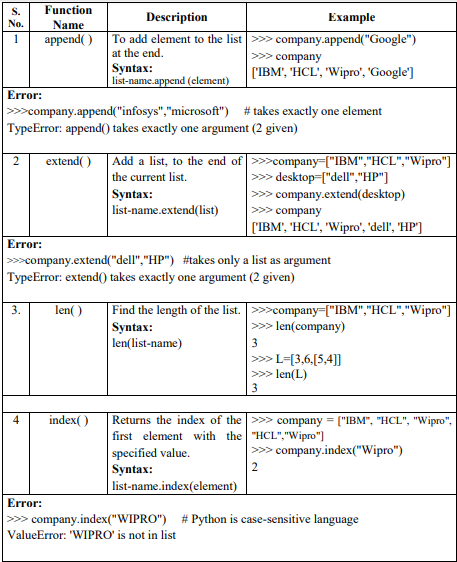
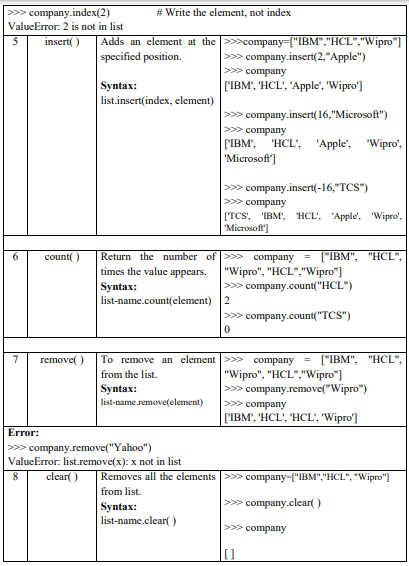
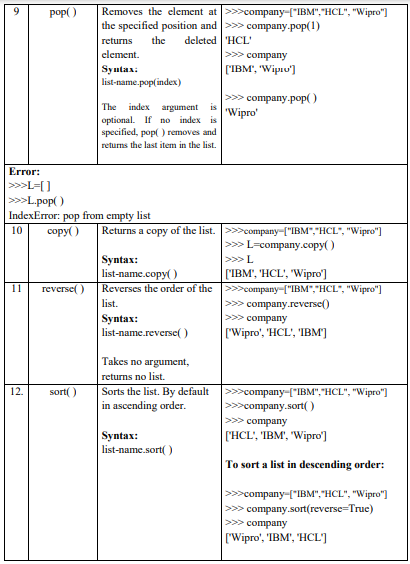
Deleting the elements from the list using del statement:
Syntax:
del list-name[index] # to remove element at specified index
del list-name[start:end] # to remove elements in list slice
Example:
>>> L=[10,20,30,40,50]
>>> del L[2] # delete the element at the index 2
>>> L
[10, 20, 40, 50]
>>> L= [10,20,30,40,50]
>>> del L[1:3] # deletes elements of list from index 1 to 2.
>>> L
[10, 40, 50]
>>> del L # deletes all elements and the list object too.
>>> L
NameError: name ‘L’ is not defined
Difference between del, remove( ), pop( ), clear( ):
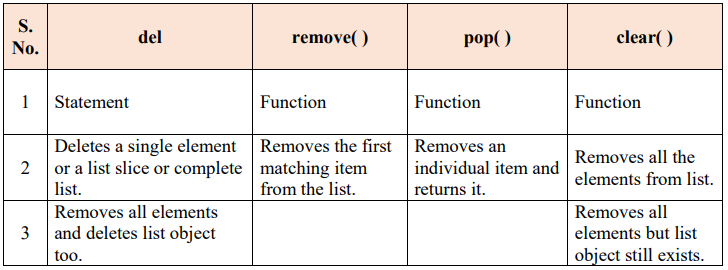
Difference between append( ), extend( ) and insert( ) :
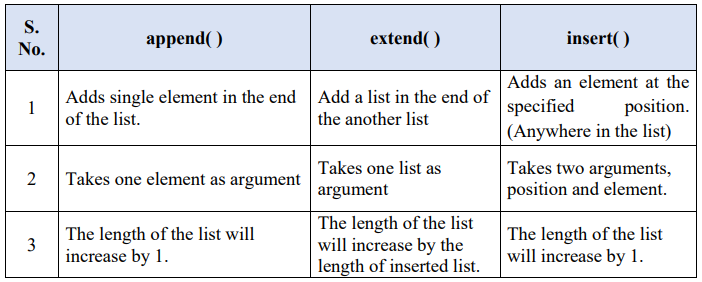
Programs related to lists in python:
Program-1 Write a program to find the minimum and maximum number in a list.
L=eval(input("Enter the elements: "))
n=len(L)
min=L[0]
max=L[0]
for i in range(n):
if min>L[i]:
min=L[i]
if max<L[i]:
max=L[i]
print("The minimum number in the list is : ", min)
print("The maximum number in the list is : ", max)
Program-2 Find the second largest number in a list.
L=eval(input("Enter the elements: "))
n=len(L)
max=second=L[0]
for i in range(n):
if max<L[i]>second:
max=L[i]
seond=max
print("The second largest number in the list is : ", second)
Program-3: Program to search an element in a list. (Linear Search).
L=eval(input("Enter the elements: "))
n=len(L)
item=eval(input("Enter the element that you want to search : "))
for i in range(n):
if L[i]==item:
print("Element found at the position :", i+1)
break
else:
print("Element not Found")
Output:
Enter the elements: 56,78,98,23,11,77,44,23,65
Enter the element that you want to search : 23
Element found at the position : 4
 Class Notes NCERT Solutions for CBSE Students
Class Notes NCERT Solutions for CBSE Students





